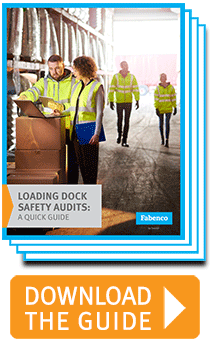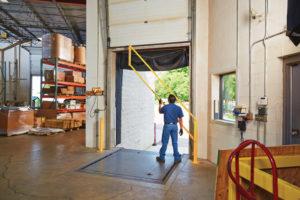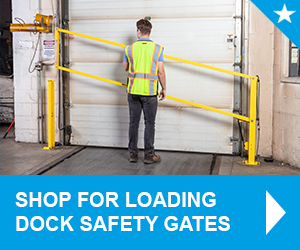
Loading docks are busy places. And that’s a good thing—that means projects are moving and your business is strong. But the busier you are, the more apt you are to overlook safety. This can be particularly true during specific seasons, like the holiday rush. Even the most insignificant things can cause an accident and slow down production. Since more than one-quarter of all industrial accidents occur here, loading dock safety should always be front and center, no matter how busy you get. Here are a few reasons why:
Believe it or not, by improving your loading dock safety protocol, you can significantly reduce your worker compensation losses that stem from these kinds of accidents. Similarly, it can also help to reduce the burden of company medical costs (more than 10 percent) attributable to loading dock injuries.
Another not-so-small reason is maintaining good standing with the Occupational Safety and Health Administration. Staying compliant with OSHA regulations not only reduces the chances of your employees hurting themselves on the job, it also helps you avoid the hefty fines that can come with failure to comply. When it comes to loading dock safety, many regulations are focused on the epicenter of dock activity—the leading edge. This includes protecting workers from falls while loading and unloading as well as preventing heavy machinery, like forklifts, from backing up over the edge.
The good news is, preventing any such accidents can be as simple as assessing your current loading dock safety protocol, making necessary changes, and installing a loading dock safety gate. Here’s a checklist of areas that warrant your attention:
Loading Dock Safety Audit
![Download The Loading Dock Safety Audits Quick Guide]() The Dock Itself
The Dock Itself
- Is your dock well lit? This is especially important during the winter months when the sun sets in the afternoon and the press of holiday shipping may require longer hours.
- Is your dock clean? Dock area floors should be kept clear of debris, spills, oil, and rain and ice from inclement weather. If your floors become slick, activities should halt until they are back in good working order.
- Are hazards well marked? Edges and other trip and fall hazards should be well marked with bright yellow paint, as should any dangerous machinery. Posters reminding workers to use safety best practices when lifting heavy loads are helpful as well.
- Do you have fire extinguishers, a first aid kit, and an AED handy? Should you have an emergency, your workers should know exactly where to find fire extinguishers, first aid, and an automatic external defibrillator (AED)—and they should have the first aid training to know how to use them all.
- Are your safety exits well marked? An emergency isn’t a time for guesswork. Safety exit signage should be clear and your employees should all know how to calmly and quickly vacate the premises.
Delivery & Shipping Vehicles
- Are your vehicles turned off? To prevent unnecessary accidents, trailer trucks and other vehicles should be turned off during loading and unloading.
- Are your vehicles chocked? Likewise, your shipping and delivery vehicles should be chocked behind the wheels during loading and unloading to prevent them from rolling away or moving.
- Do you need ramps? Obviously, the best situation is when the height of the truck and the dock are relatively equal. But when there is a considerable difference in height, using steel ramps helps make the transition of goods and materials much smoother.
Activity Around the Dock
- Are your forklifts and equipment locked up when not in use? Keeping unauthorized users safe is as simple as locking your equipment up.
- Are your workers aware of the proper load balance? Falling loads present a danger, especially when the forklift is top-loaded. Be sure to train your workers on the proper load balance (heavy at the bottom, lighter at the top) to prevent materials from toppling.
- Are your workers aware of equipment safety best practices? Workers should be reminded to be aware of the proximity of forklifts and other material movers and to heed the forklift’s horn and move well aside.
- Are your dock doors closed and locked when not in use? It is good advice, when practical, to keep the loading dock door closed and locked as much as possible.
The OSHA Fall Protection Specifics
OSHA regulations on loading dock safety require fall protection on any dock that is 48 inches or higher. If the dock door is open, dock worker protection is required. OSHA is clear that at this height or higher, using only a visual barrier—a yellow rope or chain, for example—won’t suffice. OSHA requires that you install and use a barrier such as a loading dock safety gate or guardrails to make sure your workers stay safe.
Although it’s best for dock doors to remain closed when not in use, this isn’t required—nor is it always feasible. Many factories and warehouses aren’t climate controlled, and an open dock door is required for ventilation. Likewise, leaving the dock doors open makes it easier for workers to see when a delivery truck has arrived.
Fortunately, dock gates have come a long way. Here at Fabenco, we manufacture a variety of dock gates that not only meet OSHA fall protection requirements, they are both easy to install and use. This is especially important for busy loading docks. Once you decide that a loading dock safety gate is in your future, be sure to look for the following qualities:
- Easy to install with basic tools
- Takes up minimum space
- Gas struts that make the gate easy to open
- Tapered guide on the receiver post for easy alignment when closing
These minor details may seem like just that—minor details. But the easier your dock gates are to use, the less impact they have on your productivity.
We Take OSHA Fall Protection Seriously
At Fabenco, the safety of workers at the loading-dock edge has been a priority for more than 45 years. We are the world’s foremost manufacturer of adjustable, self-closing gates and don’t view our customers as clients, we view them as partners. If you have questions about OSHA fall protection—not just on your loading docks, but your mezzanines or other at-height working environments, don’t hesitate to give us a call. We can walk you through a custom safety plan that will keep your employees healthy, happy, and productive so you can do your job—keep your business running strong.










